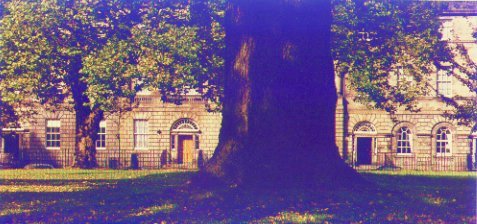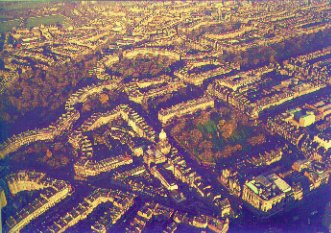
The New Town of Edinburgh.
 The so-called New Town in Edinburgh is now well over two hundred years old and was based on a plan by James Craig which emerged from a public competition in 1766. The Lord Provost, George Drummond, was determined that Edinburgh should expand beyond its rather cramped and medieval boundaries of the time and extend itself northwards of the Royal mile. The result was such a success that later extensions to the plan were made to the North, West and East.
The so-called New Town in Edinburgh is now well over two hundred years old and was based on a plan by James Craig which emerged from a public competition in 1766. The Lord Provost, George Drummond, was determined that Edinburgh should expand beyond its rather cramped and medieval boundaries of the time and extend itself northwards of the Royal mile. The result was such a success that later extensions to the plan were made to the North, West and East.
The basic layout of the first section of the New Town was a symmetrical grid with George Street at its centre, flanked by Queen Street and Princes Street. Originally meant to be residential in nature, this area is now so expensive that private owners have long gone and shops and offices dominate.
 The expansion of the New town to the North was thankfully in keeping with the Neoclassical theme established from the start and although it proved impossible to continue with the idea of broad straight streets, the resulting mixture of crescents, terraces, circuses, squares and parks has a charm all its own.
The expansion of the New town to the North was thankfully in keeping with the Neoclassical theme established from the start and although it proved impossible to continue with the idea of broad straight streets, the resulting mixture of crescents, terraces, circuses, squares and parks has a charm all its own.
Exploring the New Town is of course best done on foot, especially as the impressive facades of the main streets conceal some delightful little mews accessed from the various lanes sprouting from these streets. Some of these mews cottages command prices which would amaze you! Actually, in the city centre I have seen garages by themselves being advertised at prices which would buy my flat several times over, while the large townhouses bring amounts which could easily be confused with their telephone numbers (for a prime location the telephone number is the much smaller one!).
I won't go into details of the area, you'd do much better with a decent guidebook. I will however put in a couple of recommendations - check out the Dean village close to the West End of Princes Street and try the walkway along the Water of Leith from there. Visit the Georgian House at No.7 Charlotte Square, this is owned by the National Trust for Scotland and has been lovingly restored to be an exact replica of the life-style of such a house around 1800. Don't miss the colony houses at Glenogle Road, these were built to house the servants and workmen necessary to support the grander houses, and while they are now quite desirable residences they are a pet hate of taxi-drivers due to the difficulties of reversing out of the narrow terraces between the lines of parked cars. And finally, when your feet have had enough of tramping the pavements visit the Royal Botanic Gardens on the Northern edge of the New Town for the best way to recover.






 The expansion of the New town to the North was thankfully in keeping with the Neoclassical theme established from the start and although it proved impossible to continue with the idea of broad straight streets, the resulting mixture of crescents, terraces, circuses, squares and parks has a charm all its own.
The expansion of the New town to the North was thankfully in keeping with the Neoclassical theme established from the start and although it proved impossible to continue with the idea of broad straight streets, the resulting mixture of crescents, terraces, circuses, squares and parks has a charm all its own.

